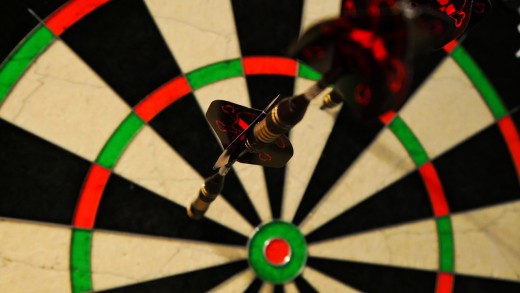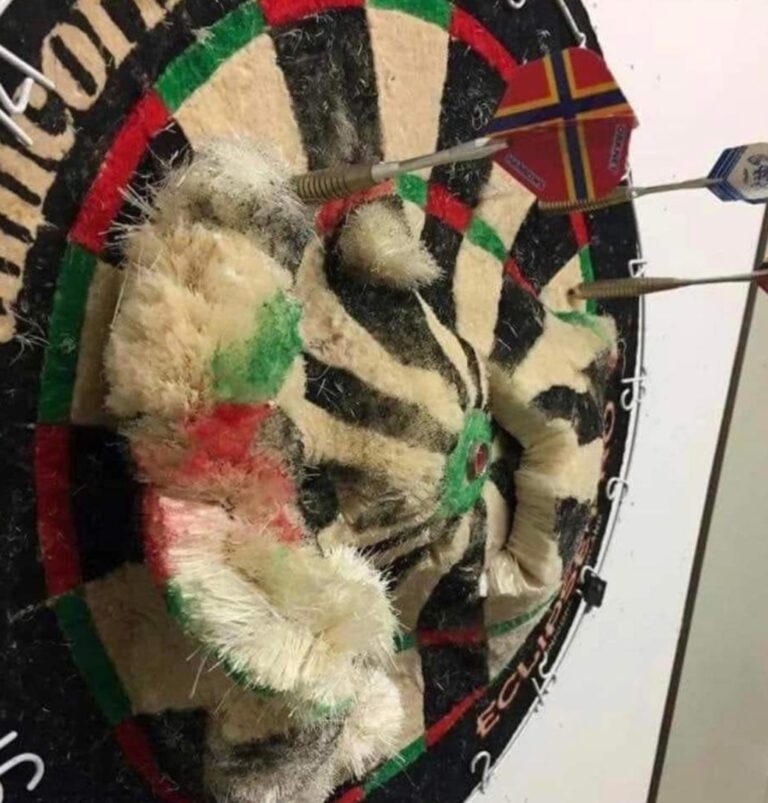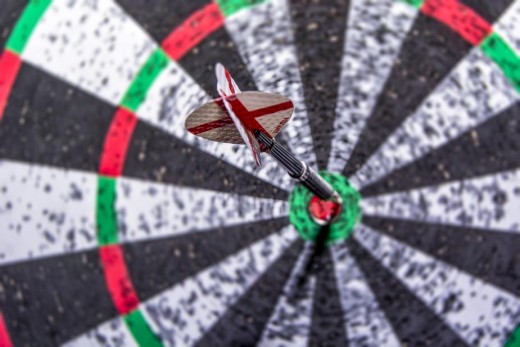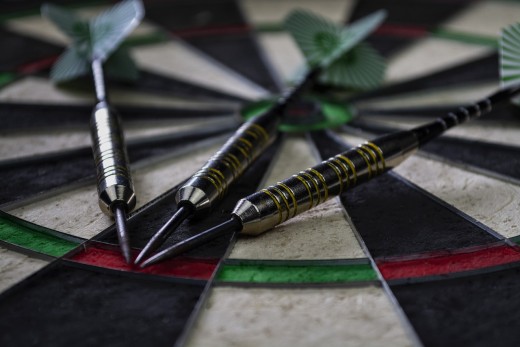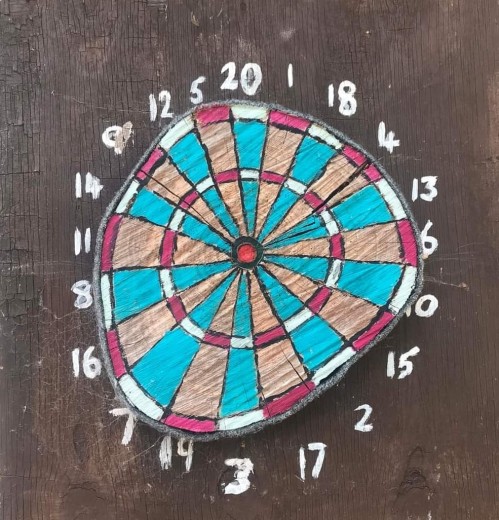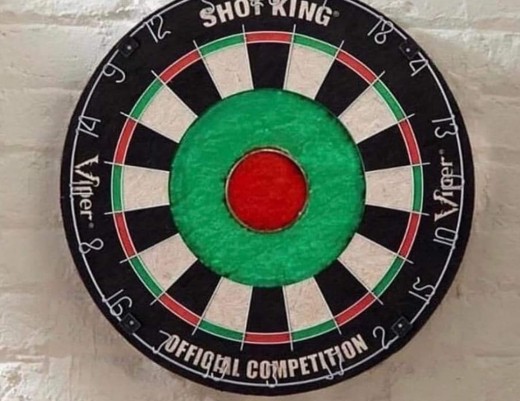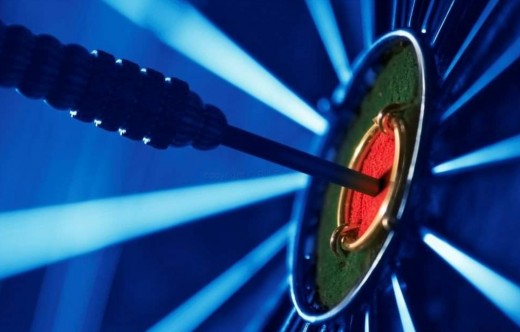Monday, July 20, 2009
Column 369
MOON DARTS (Reprinted on the occasion of the 40th Anniversary of the Moon Landing)
With all the drama and danger in the world these days – terrorism, tsunamis, monster hurricanes, and the spiraling rise in the price of gasoline – you’ve probably been deep in thought, contemplating life, the future, and wondering just exactly what it would be like to throw darts on the moon.
The concept isn’t new. According to the expert scientist I consulted while researching the issue, my wife’s brother Freddie who “placed third” as a sixth-grader at the Flint, Michigan Junior Science Fair (his project explored the effect of beer versus water on the growth of marigolds), darts have twice been thrown beyond the boundaries of Planet Earth. Freddie also notes that “beer causes flowers to, like, die, dude.”
Both darts experiences were “bummers.”
The first took place in 1973 aboard Skylab, which eventually exploded and landed in little bitty pieces on Kevin Berlyn’s garden in Woolooboogaloo, Australia. The Skylab astronauts used a set of Velcro darts and a Velcro dartboard. But the darts (actually golf ball-sized plastic balls) just “wobbled about in the ‘air’ of the vacuum station, often bouncing off the sides of the craft, and sometimes becoming lost.” So it was pretty much like the real thing.
The other darts “match” occurred in 1996 aboard the Russian Mir Space Station. Like Skylab, Mir also had its problems. There was a fire. There were computer breakdowns. There were air leaks. Once the 135-ton space station (which now also rests in little bitty pieces – in muck somewhere in the South Pacific) actually collided with its cargo re-supply ship. One must wonder what brand of vodka the genius was drinking who suggested throwing pointed objects around this calamity-prone space machine.
But it did happen. The experiment (dreamed up by a professor at MIT) involved the “videotaping of crew members playing darts to study how they might adapt to zero gravity.” Nine astronauts and cosmonauts participated. The Americans won, stole the Russian’s women, and forced them all to become professional tennis players.
There are two essential requirements to throwing darts on the moon. First, you have to pack. Second, you have to get there.
Assuming you want to live, you will need to pack a space suit. Apollo-era suits cost about $2.5 million dollars, but that was in 1970’s dollars. A similar suit today that will provide you the same freedom of motion that enabled Allan Shepherd (Apollo 14) to swing a golf club will set you back about $20 million.
Getting there won’t be cheap either. The moon’s farther than the corner bar – 250,000 miles farther, in rough terms. In current day money, the various Apollo missions cost somewhere between two and four billion dollars, approximately the same amount I paid yesterday to fill up my Jeep.
The Apollo trips were relatively quick. If you can spare a few more days from work and assuming a 747 could actually escape earth’s gravity and fly in a world void of atmosphere, you could call your travel agent for a ticket. At 400 miles per hour, twenty-six days later you’d be touching down in the regolith (according to Freddie, this is the “technical term for dirt” on the moon) and puking up a month’s worth of airline peanuts.
So, you’re on the moon, face-to-face with the Man in the Moon or, if you’re Japanese, the “Rabbit on the Moon” (don’t ask me why – that’s just what they claim to see in Japan after a night of sake). Things will look and feel different and your darts will respond a WHOLE HELL OF A LOT different than they do back at your neighborhood pub. In Australian scientific terms, they will “suck the Woolooboogaloo” even more.
Gravity on the moon is one sixth what it is in earth. There is no appreciable atmosphere. These two factors will have a profound effect on your darting experience.
But first, things will look different. The beauty and serenity of the landscape – craters, mountain ranges, and lava plains – has been described in various ways by the dozen people who have set foot on its powdery surface. “Magnificent desolation” was the term James Lovell (Apollo 8 and 13) chose to capture its essence.
If it’s daytime, you will see the moon’s surface very clearly. It will be bright, because the billions of glassy particles in the regolith reflect sunlight. This will wash out stars in the sky, which will appear black (because there is no air to diffuse the light). If you’re on the near side (the side facing earth), you’ll see the earth in the sky, about twice as large as the moon appears from earth.
If it’s nighttime and you’re on the moon’s far side, you will be on an absolutely pitch-black surface underneath a star-studded night that would make any astronomer drool. If you’re on the near side at nighttime however, it will not be quite so dark due to the reflection of light from the earth.
Since darts are best played at night, the thing to do will be to set up your board on the near side. You’ll be able to wave to your friends back on earth (they would not be able to see you from the far side, even with binoculars). The other good news is that nighttime on the moon lasts 14 days so you will be able to spend a long time at the moon bar before it closes, your wife calls, or you freeze to death.
If you wish to replicate earthly darting conditions, your dartboard will need to be approximately nine feet wide and placed approximately 46 feet from the oche you draw in the lunar dust. Probably you will want to take a buddy with you to serve as a dart fetcher, although if you throw like me he should be a brave dart buddy. A spacesuit pierced by a stray dart is not conducive to a long darting career.
One sixth earth gravity and lack of atmosphere will affect your game and overall darting experience in numerous other ways.
No atmosphere means no air, no wind, no rain, no weather (this is why the footprints of those who have walked on the moon are still there and will remain visible for centuries). The air that surrounds earth acts as a blanket to keep us warm and comfy. The absence of atmosphere on the moon means drastic temperature swings, from 260 degrees at noon to -280 degrees at night. At nighttime your beer will freeze instantly. Your cigarette won’t light. Your flights will be useless.
No atmosphere is what made possible one of the most compelling images of the Apollo program – that of David Scott (Apollo 15) dropping a hammer and a feather while standing on the lunar surface. Of course, they landed side by side and threw up dust in the same instant.
One-sixth gravity means that you will weigh one-sixth your current weight (this is the reason astronauts on the moon seem to bound from location to location). Andy Fordham will weigh in at five stone. He will bounce about the lunar dust like a bunny on springs. A 24-gram dart will weigh four grams. Bounce outs will fall slowly to the ground. The trajectory of your dart will be very flat.
Of particular interest (at least to members of the male species), the lack of gravity will have an uplifting effect on certain features of the female anatomy. Watch 10 with Bo Derek if you haven’t ever seen it. If you have, there’s no need to see it again – the scene is already burned into your brain. Female moon joggers and their significant body parts will remind you of the infamous slow-motion beach jogging scene. Everything happens slower in low-gravity – the ups, the downs, the bounces. Ah, the perky glory of low gravity.
But it is the combination of low gravity and the absence of atmosphere that will complicate your time at the line.
Imagine… you bound to the line in your protective spacesuit, rustling up poofs of confectionary sugar-like lunar dust. Forty-six feet before you on the desolate landscape, craters and mountains on the horizon, stands a giant nine-foot board.
Floating in the night sky is the awesome blue-green earth, reflecting light on the rigolith. It’s cold. Silence looms.
Now imagine that you have super-human strength and your oche is at the highest point on the moon’s equator. If you throw your dart level to the ground, east or west, at approximately 3600 miles per hour and then wait approximately one hour and fifty minutes, your dart will reappear and hit you in the back. As well as any example, this captures the huge combined effect that low gravity and lack of appreciable atmosphere will have on your moon darts experience.
Note however, that I said the dart will “hit” you in the back, not stick you. When you step back to your real oche and release your dart you will see what I mean. Without air to act on the flight and stabilize your toss, a dart thrown on the moon will NOT fly point first without considerable modification to your throwing technique. Although a release in low gravity will achieve a far less arched path than the same throw would realize on earth and although your dart will fly faster, the lack of atmosphere will cause the dart to wildly tumble, wobble, or roll.
In other words, your dart will truly travel in whatever imperfect orientation it was in when it left your hand.
There are only two ways to achieve a point first entry. Like in football, perfecting a spiral will accomplish the task. By finessing just the right amount of spin upon release (and it would have to be massive), causing the dart to spin around its longitudinal axis, will gyrostabilize it and ensure a point first entry. Alternatively, you might throw the dart as circus knife or axe throwers throw, timing the end-over-end tumble just right so the sharpe end finds the target.
The curiosity is that when presented with the cosmic and easier of two scenarios (no gravity and no atmosphere) where objects essentially travel in straight lines, versus more difficult earthly conditions (where the tug of gravity and changing implications of atmosphere wreak havoc on the trajectory of a dart in flight), humans perform miserably.
Darts just don’t seem to work in weightless or semi-weightless environments void of atmospheric conditions. But this is not because they can not work in such conditions and should not perform better than on earth. That darts didn’t work for Americans or Russians aboard Skylab or Mir and theoretically will not work without great effort on the moon, is nothing more than a commentary on the evolutionary process.
Suppose for a moment the reverse, that there are alien species living among humankind – a species that evolved in weightless conditions and which, suddenly, after countless generations, try throwing darts in conditions such as those confronted on Skylab or Mir or as exist on the moon.
It only stands to reason that the aliens will be substantially more proficient at this easier version of the game and perform miserably under standard, more difficult earthly conditions. The same logic suggests that if darts is played at an oche 20 yards under the sea, a tuna will whoop Phil Taylor.
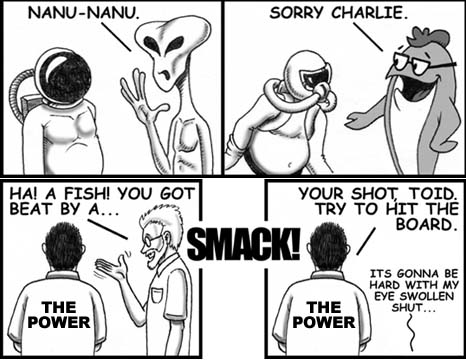
Humans have adapted well to an extraordinarily complex earthly darts environment. We have learned how to aim and score with a free moving body that moves in a parabolic arc under the influence of gravity. Air conditioning blows. Beer flows. Pretty girls wander about the joint. All of this complicates the action of the dart and our ability to maintain focus and proper trajectory. Yep, we earthlings are pretty damn talented.
But none of us are good enough to beat an alien or a fish.
From the Field,
Dartoid

